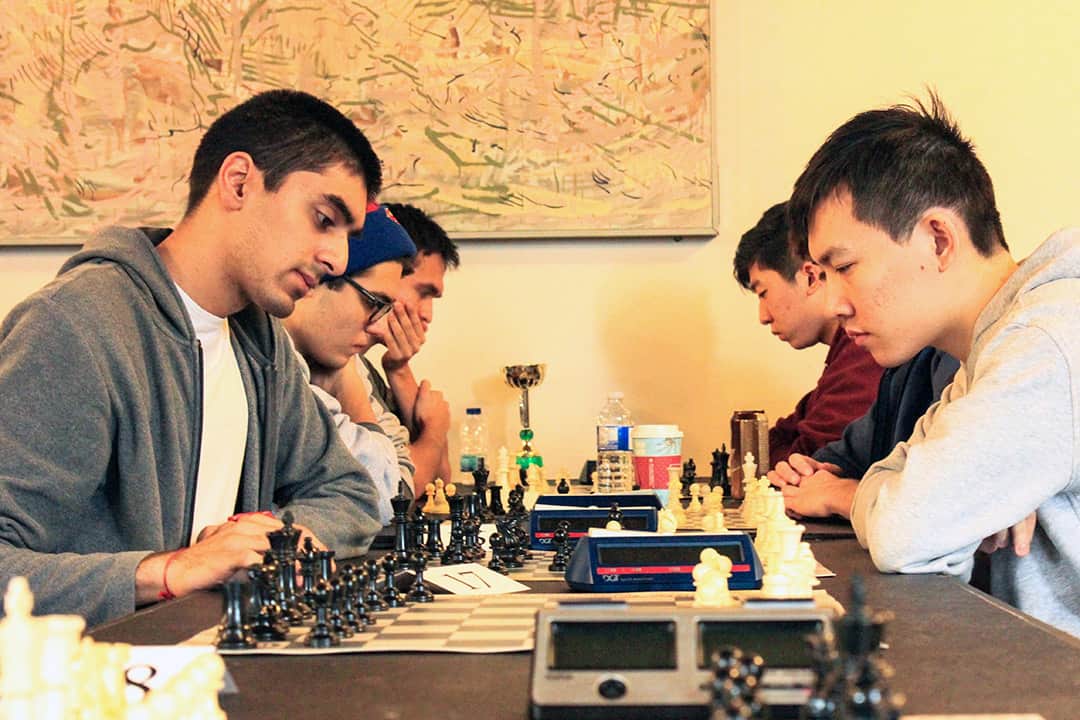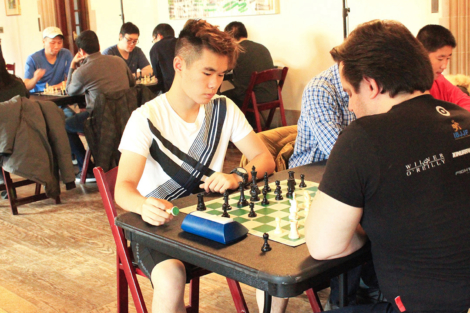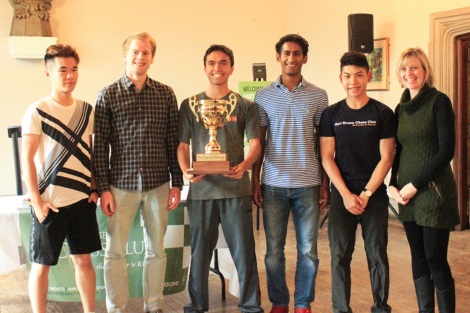It was a gloomy morning on Friday, November 9. I sat in the Hart House South Dining Room waiting to experience my first chess tournament. As a childhood fan of chess, I was looking forward to the tournament — even if I was a complete outsider to the world of competitive chess.
Held on U of T soil, the first-ever Ivy League Challenge took place from November 9–11, bringing together top university chess players from across the continent. Teams from Yale University, Harvard University, the University of Michigan, and Princeton University travelled to Toronto to participate in the three-day event.
“We have invited some of the best chess schools, the best universities in the northeast,” Panayoti Tsialas, Tournament Director and Hart House Chess Club’s Fundraiser Executive, told me.
“I would dare say that this is the second strongest student competition, probably in the continent, based on the strength of the people who are participating.”
The tournament
As each round officially began, the room would fall silent. Many players donning sweaters from their respective universities would periodically stand up, stretch, and walk around, glancing at other matches or grabbing a glass of water.
The tournament followed World Chess Federation (FIDE) rules and procedures. Each opponent had an hour and a half of time to play; this left plenty of time to think deeply about the game, analyze the board, and wait for an opponent to move.
Players received one point for winning a match, a half point for a tie, and zero points for losing. If a team’s combined score was higher than 2.5 in a round, the team received one match point. A half match point was awarded if the combined score was two, and zero match points were awarded if the combined score was 1.5 or less.
The Ivy League Challenge had six teams of four — two U of T teams and one team per visiting university — with two alternate players.
Team chess is different from individual chess, U of T student and FIDE Woman Grandmaster Qiyu Zhou told me. In team chess, players care about the collective result of the team over their individual games.
“Regardless of whether you think that your individual position is promising, if your team would need just half a point in order to get to two points [and a] half… you might agree to withdraw precisely for the team to win,” she said. Riskier strategies, Zhou informed me, reflect on the whole team.
Co-captain of the Princeton chess team Aaron Balleisen said that participating in chess tournaments is “way more fun when you’re doing it with other people,” noting that his high school did not have a chess team.
The tournament was also broadcast live through chess5.com. Broadcasting the games made the tournament accessible to a greater number of people who could follow and comment on matches as they happened.
“It can be a very exciting sport to watch,” Tsialas said, “because unlike football or other sports where, by watching, you don’t exactly participate… in chess you can make your own calculations as the game goes on. You can actually sort of bring yourself to the position of the player.”
Players, teammates, students
Unlike some schools, the players who competed in this tournament are not offered chess scholarships. This means that school comes before chess, and it can be challenging for the players to find time to prepare for tournaments like the Ivy League Challenge.
“When you’re in [kindergarten to grade 12] you’re a lot more active in tournaments — just the way your life is structured. But once you get to college, it becomes a lot harder to play,” second co-captain of the Princeton team Isaac Martinez told me.
Martinez’s thoughts were echoed by most of the players I spoke to.
University of Toronto Team B captain Nikita Gusev said that practising as a team can be difficult because “everyone has busy schedules and most of us do stuff on the weekends too, like teaching chess or a lot of part-time jobs.”
U of T was fortunate to have Zhou — a first-year Trinity student hoping to double major in economics and math — on our team. Having won her first medal at five, Zhou is now a FIDE Master and Woman Grandmaster in chess. The 18-year-old started playing competitively in Finland and has participated at the Women’s Chess Olympiad — known as the Olympics of chess — as part of team Canada since 2014. In 2016, Zhou won the Canadian women’s chess championship.
Given her background and how frequently she travels and plays games, Zhou said that most of her peers know her as “the girl who plays chess,” and the Ivy League tournament presented an opportunity for Zhou’s peers to watch her play.
When I asked Zhou how she prepared for the tournament, she said that, for most players, “preparation is something that has accumulated over several years.” Despite school being her focus, Zhou did try to complete “a couple of puzzles here and there” during reading week.
Zhou was also the only woman to compete in the 24-player Ivy League tournament.
“I’ve been pretty much the only woman player playing in tournaments since I was five, when I won the Finnish National Championships, [which] is for under-10 boys,” Zhou said. “As the only female in most men’s tournaments, it’s sort of empowering in the sense that I really want to get other women into playing [chess], but also I’m proud of the fact that I’m able to compete on the same level as a lot of these top male players.”
The results
In the end, U of T came in fifth and sixth place. After a three-way tie leading into the final round, Princeton came in first place, Michigan and Harvard tied in second, and Yale came in fourth.
Gusev said that the U of T teams were “definitely underdogs” in the competition, but they put up “a good fight.”
The top four individual board prizes were given out to Martinez — who won all five of his games — Princeton’s Kapil Chandran, and Michigan’s Mark Heimann and Safal Bora. The best game of the tournament was awarded to Atulya Shetty from Michigan and Chandran.
When the award ceremony was finished, in typical chess tournament fashion, a charity blitz tournament followed. In the blitz, each player had a mere three minutes to play and the games progressed quickly. Members of the public were welcome to participate.
A community game
The University of Toronto Chess Club was founded on October 24, 1895, at University College. Predating Hart House, the club’s 123-year-history makes it the oldest chess club in the country. Today, the Hart House Chess Club welcomes all. The club currently has 82 members and, in addition to hosting and participating in competitive chess tournaments, it provides weekly lessons, casual tournaments, and lectures.
The Hart House Chess Club hopes to build on the relationships that it established with other universities and continue promoting chess on and off campus through the tournament in future years.
Throughout the weekend, I asked players and organizers how they got involved in chess and why they continue to participate in it. Hart House Chess Club’s Alumni Chair, Ben Hahn, expressed a common sentiment: “Chess is in my blood and I don’t think I can get rid of it. I’m probably just an average player, but I enjoy the game, I enjoy the people, and I enjoy the environment.”
While observing the tournament, I came to agree that chess is much more than an individual game. It’s a collective experience — one that I was grateful to observe.




